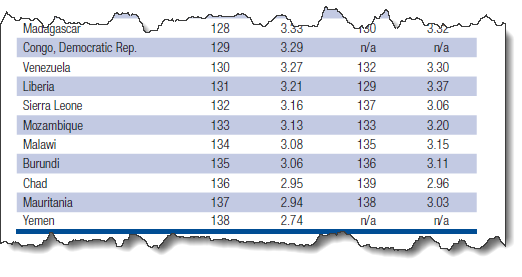This September 2016 the World Economic Forum (WEF) published its annual Global Competitiveness Report 2016-17. This report is almost 400 pages of a fairly comprehensive analysis of each country in the world and its relative competitiveness based on 12 separate factors (shown below):
And based on these 12 factors, the factors themselves are broken down into key elements for:
- Factor-Driven Economies
- Efficiency-Driven Economies, and
- Innovation-Driven Economies
For instance Institutions and Infrastructure are key "Basic" requirements necessary for an economy to thrive and compete.
The WEF analysis then used these factors to ascertain the competitiveness of a country relative to the rest of the world as well as to its geographic region in many cases. For instance, the top 10 most competitive countries using this methodology are:
And the bottom 10 are:
Infrastructure Factor
The elements reviewed to calculate each factor are listed in the "Technical Notes and Sources" section at the end of the report. Since this blog is focused on infrastructure there is interest on the elements included in this calculation. These include the following:
- Quality of overall infrastructure
- Quality of roads
- Quality of railroad infrastructure
- Quality of port infrastructure
- Quality of air transport infrastructure
- Available airline seat kilometers
- Quality of electricity supply
- Mobile-cellular telephone subscriptions
- Fixed telephone lines
At first glance, this list is missing such elements as fresh/potable water supply, food availability and distribution, etc. However, the "Technological Readiness" factors include the following that could be considered part of the strength of a country's infrastructure:
- Availability of latest technologies
- Firm-level technology absorption
- Foreign Direct Investment and technology transfer
- Internet users
- Fixed broadband Internet users
- Internet bandwidth
- Mobile broadband subscriptions
Conclusion
As usual, the quality and content of this report are very good. It is compelling and interesting and a useful reference for country policy development.
###















